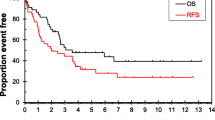Purpose
The purpose of this study was to investigate the association of bacterial translocation with long-term disease-specific and disease-free survival in colorectal cancer patients.
Methods
This was a prospective cohort study in which 128 and 30 colorectal cancer patients undergoing curative and palliative resections, respectively, were recruited between 1992 and 1997. Samples of mesenteric lymph nodes were harvested for culture before administration of prophylactic antibiotics. Median follow-up for patients without cancer death was 103 (range, 72–147) months. This cohort of patients was internally validated by Dukes staging.
Results
The cumulative disease-specific survival (time to death) and disease-free survival (time to recurrence) for all patients at five years of follow-up was 55 percent (standard error [SE], 4.4 percent) and 65 percent (SE, 4.8 percent), respectively. Bacteria were isolated from the mesenteric nodes of 23 (15 percent) patients. There was no association between bacterial translocation and nodal metastases, bowel obstruction, and septic complications. Patients with confirmed bacterial translocation had a worse disease-specific survival (n=158, 5-year survivorship estimates±SE, 38 percent±12 percent vs. 58 percent±4.7 percent; P < 0.01) and disease-free survival (n=128, 5-year survivorship estimates±SE, 46 percent±14 percent vs. 66 percent±5 percent; P = 0.004) than those without. Using multivariate Cox regression analysis, bacterial translocation was a predictor of disease-specific survival (P = 0.011) and disease-free survival (P = 0.02) independent of other pathologic prognostic indicators.
Conclusion
Colorectal cancer patients with bacterial translocation in the mesenteric lymph nodes have a worse outcome.



Similar content being viewed by others
References
PC Sedman J MacFie P Sagar et al. (1994) ArticleTitleThe prevalence of gut translocation in humans Gastroenterology 107 643–649 Occurrence Handle8076751 Occurrence Handle1:STN:280:DyaK2czlslelsg%3D%3D
CJ O’Boyle J MacFie CJ Mitchell et al. (1998) ArticleTitleMicrobiology of bacterial translocation in humans Gut 42 29–35 Occurrence Handle9505882 Occurrence Handle1:STN:280:DyaK1c7ms1Orsw%3D%3D Occurrence Handle10.1136/gut.42.1.29
J MacFie C O’Boyle CJ Mitchell et al. (1999) ArticleTitleGut origin of sepsis: a prospective study investigating associations between bacterial translocation, gastric microflora, and septic morbidity Gut 45 223–228 Occurrence Handle10403734 Occurrence Handle1:STN:280:DyaK1Mzjt1alsg%3D%3D Occurrence Handle10.1136/gut.45.2.223
JC Alverdy F Rocha (1999) ArticleTitleSurgical stress, bacteria, and mucosal immune function Eur J Pediatr Surg 9 210–213 Occurrence Handle10532259 Occurrence Handle1:STN:280:DC%2BD3c%2FgtVSmuw%3D%3D
WE Owens RD Berg (1980) ArticleTitleBacterial translocation from the gastrointestinal tract of athymic (nu/nu) mice Infect Immun 27 461–467 Occurrence Handle6966611 Occurrence Handle1:STN:280:DyaL3c3gtlCrsA%3D%3D
RD Berg E Wommack EA Deitch (1988) ArticleTitleImmunosuppression and intestinal bacterial overgrowth synergistically promote bacterial translocation Arch Surg 123 1359–1364 Occurrence Handle3178484 Occurrence Handle1:STN:280:DyaL1M%2FisFWmtg%3D%3D
RD Berg (1983) ArticleTitleBacterial translocation from the gastrointestinal tract of mice receiving immunosuppressive chemotherapeutic agents Curr Microbiol 8 285–292 Occurrence Handle10.1007/BF01577729 Occurrence Handle1:CAS:528:DyaL3sXks1eqtrY%3D
RL Penn RD Maca RD Berg (1985) ArticleTitleLeukaemia promotes the translocation of indigeneous bacteria from the gastrointestinal tract to the mesenteric lymph nodes and other organs Microecol Ther 15 85–91
CH Tancrede AO Andremont (1985) ArticleTitleBacterial translocation and gram-negative bacteremia in patients with hematological malignancies J Infect Dis 152 99–103 Occurrence Handle3925032 Occurrence Handle1:STN:280:DyaL2M3jsFymsA%3D%3D
J MacFie BS Reddy M Gatt PK Jain R Sowdi CJ Mitchell (2006) ArticleTitleBacterial translocation studied in 927 patients over 13 years Br J Surg 93 87–93 Occurrence Handle16288452 Occurrence Handle10.1002/bjs.5184 Occurrence Handle1:STN:280:DC%2BD2MnptVajtg%3D%3D
F Song AM Lenny (1998) ArticleTitleAntimicrobial prophylaxis in colorectal surgery: a systematic review of randomized controlled trials Br J Surg 85 1232–1241 Occurrence Handle9752867 Occurrence Handle10.1046/j.1365-2168.1998.00883.x Occurrence Handle1:STN:280:DyaK1cvitlOruw%3D%3D
DC Baumgart AU Dignass (2002) ArticleTitleIntestinal barrier function Curr Opin Clin Nutr Metab Care 5 685–694 Occurrence Handle12394645 Occurrence Handle10.1097/00075197-200211000-00012 Occurrence Handle1:CAS:528:DC%2BD3sXptFCk
RL Penn RD Maca RD Berg (1985) ArticleTitleIncreased translocation of bacteria from the gastrointestinal tracts of tumor-bearing mice Infect Immun 47 793–798 Occurrence Handle3972454 Occurrence Handle1:STN:280:DyaL2M7ivFGisA%3D%3D
G Pawelec (2004) ArticleTitleImmunotherapy and immunoselection-tumour escape as the final hurdle FEBS Lett 567 63–66 Occurrence Handle15165894 Occurrence Handle10.1016/j.febslet.2004.02.091 Occurrence Handle1:CAS:528:DC%2BD2cXksVGht74%3D
IT Manyonda DE Shaw A Foulkes et al. (1986) ArticleTitleRenal cell carcinoma: blood transfusion and survival BMJ 293 537–538 Occurrence Handle3092905 Occurrence Handle1:STN:280:DyaL2s%2FgtFWlsw%3D%3D Occurrence Handle10.1136/bmj.293.6546.537-a
DA Kooby J Stockman L Ben-Porat et al. (2003) ArticleTitleInfluence of transfusions on perioperative and long-term outcome in patients following hepatic resection for colorectal metastases Ann Surg 237 860–869 Occurrence Handle12796583 Occurrence Handle10.1097/00000658-200306000-00015
EA Deitch DZ Xu L Qi et al. (1991) ArticleTitleBacterial translocation from the gut impairs systemic immunity Surgery 109 269–276 Occurrence Handle2000558 Occurrence Handle1:STN:280:DyaK3M7lslWgsw%3D%3D
Berg RD. Translocation of indigenous bacteria from the intestinal tract. In: Hentges DJ, ed. Human intestinal microflora in health and disease. San Diego: Academic Press, 1983: 332–352
Author information
Authors and Affiliations
Corresponding author
About this article
Cite this article
Chin, K.F., Kallam, R., O’Boyle, C. et al. Bacterial Translocation May Influence the Long-Term Survival in Colorectal Cancer Patients. Dis Colon Rectum 50, 323–330 (2007). https://doi.org/10.1007/s10350-006-0827-4
Published:
Issue Date:
DOI: https://doi.org/10.1007/s10350-006-0827-4




